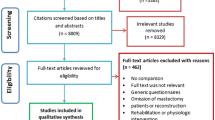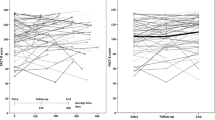Abstract
Purpose
The purpose of this work was to evaluate the patient-borne financial cost of common, adverse breast cancer treatment-associated effects, comparing cost across women with or without these side effects.
Methods
Two hundred eighty-seven Australian women diagnosed with early-stage breast cancer were prospectively followed starting at 6 months post-surgery for 12 months, with three monthly assessments of detailed treatment-related side effects and their direct and indirect patient costs attributable to breast cancer. Bootstrapping statistics were used to analyze cost data, and adjusted logistic regression was used to evaluate the association between costs and adverse events from breast cancer. Costs were inflated and converted from 2002 Australian to 2014 US dollars.
Results
More than 90 % of women experienced at least one adverse effect (i.e., post-surgical issue, reaction to radiotherapy, upper-body symptoms or reduced function, lymphedema, fatigue, or weight gain). On average, women paid $5,636 (95 % confidence interval (CI), $4,694, $6,577) in total costs. Women with any one of the following symptoms (fatigue, reduced upper-body function, upper-body symptoms) or women who report ≥4 adverse treatment-related effects, have 1.5 to nearly 4 times the odds of having higher healthcare costs than women who do not report these complaints (p < 0.05).
Conclusions
Women face substantial economic burden due to a range of treatment-related health problems, which may persist beyond the treatment period. Improving breast cancer care by incorporating prospective surveillance of treatment-related side effects and strategies for prevention and treatment of concerns (e.g., exercise) has real potential for reducing patient-borne costs.
Similar content being viewed by others
References
American Cancer Society (2013) Cancer facts and figures 2013. American Cancer Society, Atlanta
Curt G, Breitbart W, Cella D, Groopman J, Horning S, Itri L, Johnson D, Miaskowski C, Scherr S, Portenoy R, Vogelzang N (2000) Impact of cancer-related fatigue on the lives of patients: new findings from the fatigue coalition. Oncologist 5:353–360
Hassett M, O’Malley A, Pakes J, Newhouse J, Earle C (2006) Frequency and cost of chemotherapy-related serious adverse effects in a population sample of women with breast cancer. J Natl Cancer I 98(16):1108–1117
Ligibel J, Denlinger C (2013) New NCCN guidelines for survivorship care. J Natl Compr Cancer Netw 11:640–644
Rock C, Doyle C, Demark-Wahnefried W, Meyerhardt J, Courneya K, Schwartz A, Bandera E, Hamilton K, Grant B, McCullough M, Byers T, Gansler T (2012) Nutrition and physical activity guidelines for cancer survivors. CA-Cancer J Clin 62(4):243–274
Schmitz K, Courneya K, Matthews C, Demark-Wahnefried W, Galvao D, Pinto B, Irwin M, Wolin K, Segal R, Lucia A, Schneider C, von Gruenigen V, Schwartz A, American College of Sports Medicine (2010) American College of Sports Medicine roundtable on exercise guidelines for cancer survivors. Med Sci Sport Exer 42:1409–1426
Silver J, Baima J (2013) Cancer prehabilitation: an opportunity to decrease treatment-related morbidity, increase cancer treatment options, and improve physical and psychological health outcomes. Am J Phys Med Rehabil 92(8):715–727
Silver J, Baima J, Mayer R (2013) Impairment-driven cancer rehabilitation: an essential component of quality care and survivorship. CA Cancer J Clin 65(5):295–317
Cheville A, Beck L, Petersen T, Marks R, Gamble G (2009) The detection and treatment of cancer-related functional problems in an outpatient setting. Support Care Cancer 17(1):61–67. doi:10.1007/s00520-008-0461-x
Binkley J, Harris S, Levangie P, Pearl M, Guglielmino J, Kraus V, Rowden D (2012) Patient perspectives on breast cancer treatment side effects and the prospective surveillance model for physical rehabilitation for women with breast cancer. Cancer 118(supplement 8):2207–2216
Stout NL, Binkley JM, Schmitz KH, Andrews K, Hayes SC, Campbell KL, McNeely ML, Soballe PW, Berger AM, Cheville AL, Fabian C, Gerber LH, Harris SR, Johansson K, Pusic AL, Prosnitz RG, Smith RA (2012) A prospective surveillance model for rehabilitation for women with breast cancer. Cancer 118(8 Suppl):2191–2200. doi:10.1002/cncr.27476
Hayes S, Johanssen K, Alfano C, Schmitz K (2011) Exercise for breast cancer survivors: bridging the gap. Transl Behav Med 1:539–544
Gordon LG, Scuffham P, Battistutta D, Graves N, Tweeddale M, Newman B (2005) A cost-effectiveness analysis of two rehabilitation support services for women with breast cancer. Breast Cancer Res Tr 94(2):123–133. doi:10.1007/s10549-005-5828-9
Gordon L, Scuffham P, Hayes S, Newman B (2007) Exploring the economic impact of breast cancers during the 18 months following diagnosis. Psycho-Oncol 16(12):1130–1139
Private Health Insurance Administration Council (2013) Privately insured people with hospital treatment cover. Annual analysis by Sex, Age and State. PHIAC, Australian Capital Territory
Lauzier S, Levesque P, Mondor M, Drolet M, Coyle D, Brisson J, Masse B, Provencher L, Robidoux A, Maunsell E (2013) Out-of-pocket costs in the year after early breast cancer among Canadian women and spouses. J Natl Cancer I 105(4):280–292
Meneses K, Azuero A, Hassey L, McNess P, Pisu M (2012) Does economic burden influence quality of life in breast cancer survivors? Gynecol Oncol 124(3):437–443
Pisu M, Azuero A, Meneses K, Burkhardt J, McNess P (2011) Out-of-pocket cost comparison between Caucasian and minority breast cancer survivors in the Breast Cancer Education Intervention (BCEI). Breast Cancer Res Tr 127(2):521–529
McDougall J, Ramsey S (2014) Financial toxicity: a growing concern among cancer patients in the United States. ISPOR Connect 20(2)
Gordon L, Ferguson M, Chambers S, Dunn J (2009) Fuel, beds, meals and meds: out-of-pocket expenses for patients with cancer in rural Queensland. Cancer Forum 33(3):202–208
Mujahid M, Janz N, Hawley S, Griggs J, Hamilton A, Graff J, Katz S (2011) Racial/ethnic differences in job loss for women with breast cancer. J Cancer Survivorship 5(1):102–111
Jagsi R, Pottow J, Griffith K, Bradley C, Hamilton A, Graff J, Katz S, Hawley S (2014) Long-term financial burden of breast cancer: experiences of a diverse cohort of survivors identified through population-based registries. J Clin Oncol. doi:10.1200/JCO.2013.53.0956
Shih Y, Xu Y, Cormier J, Giordano S, Ridner S, Buchholz T, Perkins G, Elting L (2009) Incidence, treatment costs, and complications of lymphedema after breast cancer among women of working age: a 2-year follow-up study. J Clin Oncol 27(12):2007–2014
Calhoun E, Chang C, Welshman E, Fishman D, Lurain J, Bennett C (2001) Evaluating the total costs of chemotherapy-induced toxicity: results from a pilot study with ovarian cancer patients. Oncologist 6(5):441–445
Schnur J, Graff Zivin J, Mattson D (2012) Acute skin toxicity-related, out-of-pocket expenses in patients with breasat cancer treated with external beam radiotherapy: a descriptive, exploratory study. Support Care Cancer 20:3105–3113
Hayes SC, Janda M, Cornish B, Battistutta D, Newman B (2008) Lymphoedema following breast cancer: incidence, risk factors and effect on upper body function. J Clin Oncol 26(21):3536–3542
Beaton D, Katz J, Fossel A, Wright J, Tarasuk V, Bombardier C (2001) Measuring the whole or the parts? validity, reliability, and responsiveness of the disabilities of the arm, shoulder and hand outcome measure in different regions of the upper extremity. J Hand Ther 14(2):128–146
Cella D, Tulsky D, Gray G, Sarafian B, Linn E, Bonomi A, Silberman M, Yellen S, Winicour P, Brannon J (1993) The functional assessment of cancer therapy scale: development and validation of the general measure. J Clin Oncol 11(3):570–579
Hayes SC, Rye S, Battistutta D, Newman B (2010) Prevalence of upper-body symptoms following breast cancer and its relationship with upper-body function and lymphedema. Lymphology 43(4):178–187
Ward L, Bunce I, Cornish B, Mirolo B, Thomas B, Jones L (1992) Multifrequency bioelectrical impedance augments the diagnosis and management of lymphedema in post-mastectomy patients. Eur J Clin Invest 22:751–754
Hayes SC, Janda M, Cornish B, Battistutta D, Newman B (2008) Lymphoedema secondary to breast cancer: how choice of measure influences diagnosis, prevalence and identifiable risk factors. Lymphology 41(1):18–28
Smoot B, Wong J, Cooper B, Wanek L, Topp K, Byl N, Dodd M (2010) Upper extremity impairments in women with or without lymphedema following breast cancer treatment. J Cancer Survivorship 4:167–178
Jeong H, Sim Y, Hwang K, Kim G (2011) Causes of shoulder pain in women with breast cancer-related lymphedema: a pilot study. Yonsei Med J 52:661–667
Button J, Scott J, Taghizadeh R, Weiler-Mithoff E, Hart A (2010) Shoulder function following autologous latissimus dorsi breast reconstruction. A prospective three year observational study comparing quilting and non-quilting donor site techniques. Journal of Plastic Reconstr Aesthet Surg 63:1505–1512
Australian Bureau of Statistics (2003) Average weekly earnings (cat. no. 6302.0). Australian Bureau of Statistics, Canberra
Australian Bureau of Statistics (1997) Unpaid Work and the Australian Economy 1997. Australian Bureau of Statistics, Canberra
Schmitz K, Speck R, Rye S, DiSipio T, Hayes SC (2012) Prevalence of breast cancer treatment sequelae over six years of follow-up: the Pulling Through Study. Cancer 118(8):S2217–2225
Speck R, Courneya KS, Masse L, Duval S, Schmitz K (2010) An update of controlled physical activity trials in cancer survivors: a systematic review and meta-analysis. J Cancer Survivorship 4(2):87–100
Hayes S, Spence R, Galvao D, Newton R (2009) Australian Association for Exercise and Sport Science position stand: optimising cancer outcomes through exercise. J Sci Med Sport 12:428–434
Gordon L, Patrao T, Hawkes A (2012) Can colorectal cancer survivors recall their medications and doctor visits reliably? BMC Health Serv Res 12:440
Lubeck D, Hubert H (2005) Self-report was a viable method for obtaining health care utilization data in community-dwelling seniors. J Clin Epidemiol 58:286–290
Pinto D, Robertson M, Hansen P, Abbott J (2011) Good agreement between questionnaire and administrative databases for health care use and costs in patients with osteoarthritis. BMC Med Res Methodol 11:45
Reijneveld S, Stronks K (2001) The validity of self-reported use of health care across socioeconomic strata: a comparison of survey and registration data. Int J Epidemiol 30:1407–1414
van den Brink M, van den Hout W, Stiggelbout A, Putter H, van de Velde C, Kievit J (2005) Self-reports of health-care utilization: diary or questionnaire? Int J Technol Assess Health Care 21(3):298–304
Acknowledgments
The authors wish to acknowledge the contributions of the women who participated in the Pulling Through Study. We would also like to acknowledge the National Breast Cancer Foundation (NBCF) for funding the Pulling Through Study, and the fellowship funding support provided by NBCF (SH, TD) and Cancer Council Queensland (SH).
Conflict of interest
Authors Schmitz, DiSipio, Gordon, and Hayes declare that they have no conflict of interest.
Author information
Authors and Affiliations
Corresponding author
Rights and permissions
About this article
Cite this article
Schmitz, K.H., DiSipio, T., Gordon, L.G. et al. Adverse breast cancer treatment effects: the economic case for making rehabilitative programs standard of care. Support Care Cancer 23, 1807–1817 (2015). https://doi.org/10.1007/s00520-014-2539-y
Received:
Accepted:
Published:
Issue Date:
DOI: https://doi.org/10.1007/s00520-014-2539-y




